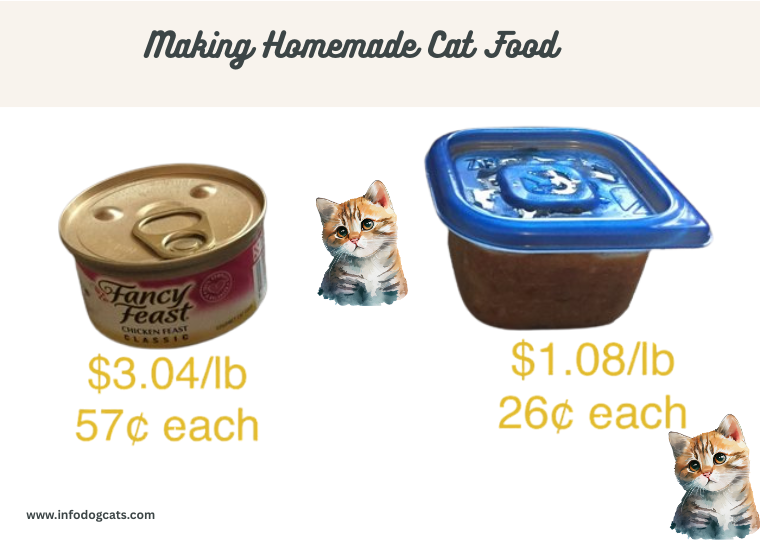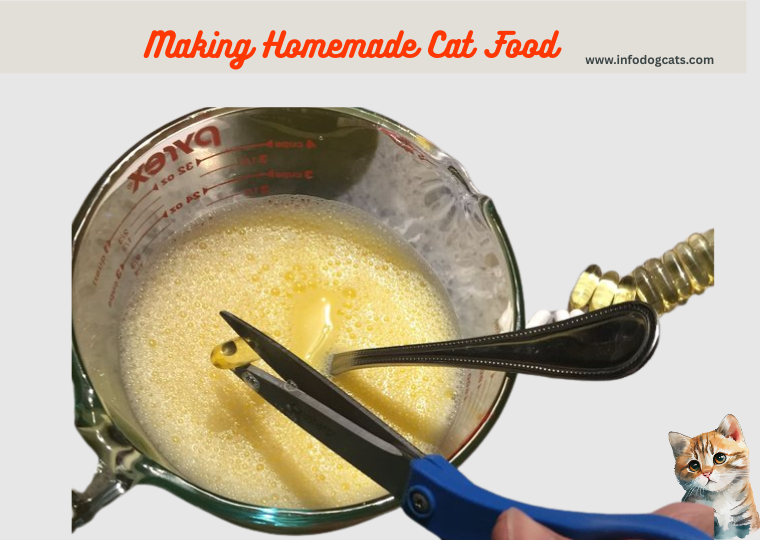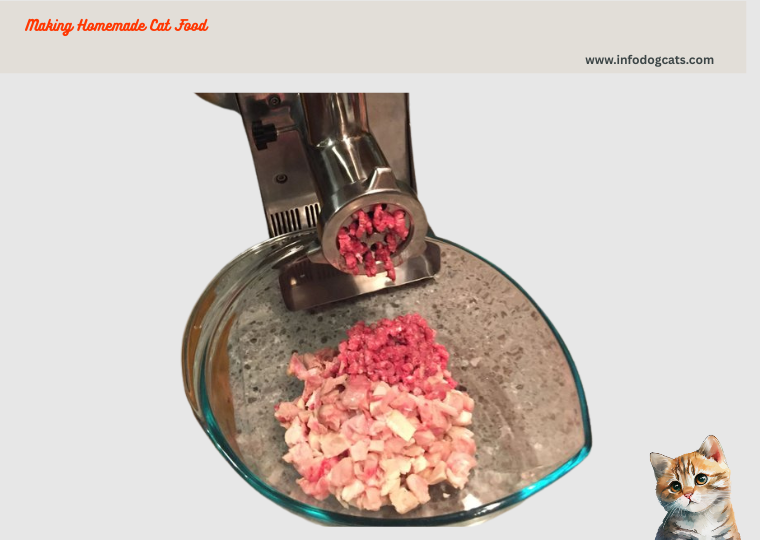With the rising cost of commercial cat food in Australia, more and more pet parents are exploring homemade alternatives. But is making your own cat food really worth the effort? The answer is a resounding yes — when done right, homemade cat food can be healthier, cheaper, and more sustainable than store-bought options.
In this guide, we’ll walk you through:
-
The benefits of homemade cat food
-
Cost comparisons with popular brands
-
Vet-backed nutritional guidelines
-
A simple, balanced DIY cat food recipe
-
Step-by-step preparation tips
Whether you’re looking to improve your cat’s health, reduce your environmental footprint, or simply save money, this article is your complete starting point.
Important Note: Always consult with a vet before changing your cat’s diet — especially if your cat has underlying health conditions.
Why Consider Homemade Cat Food?
Commercial cat food, even premium brands, often contains fillers, preservatives, and artificial additives that may not align with your cat’s natural dietary needs. While these products are convenient, they are typically mass-produced and may prioritise shelf life over nutrition. For many Australian cat owners, especially those with indoor cats or pets with sensitive digestion, this raises real concerns.
Homemade cat food offers a way to take control of your feline’s nutrition. By selecting fresh, high-quality ingredients, you can eliminate unnecessary carbohydrates, synthetic flavours, and low-grade meat byproducts. Instead, you can focus on providing a protein-rich, moisture-heavy diet that better mimics what cats would naturally eat in the wild.
In addition to improved nutrition, cost is a major motivator. Many families are noticing the ongoing rise in pet food prices, particularly for canned or specialty formulas. With thoughtful planning and a bit of preparation, homemade cat food can be significantly more affordable over time — especially when bought in bulk or during supermarket sales. Though there’s a small upfront investment in tools and supplements, these costs are often recouped within the first few months.
Finally, preparing food at home gives pet owners peace of mind. You know exactly what’s going into your cat’s bowl, and you can adapt the recipe to suit their tastes or allergies. For cats with special dietary needs, making meals at home can be a practical, vet-approved alternative to expensive prescription diets.
Nutritional Guidelines for Homemade Cat Food (Vet-Approved)
Cats are obligate carnivores, meaning their bodies are biologically designed to thrive on a diet primarily composed of animal-based protein. Unlike dogs or humans, they cannot efficiently digest large amounts of carbohydrates or plant-based ingredients. Therefore, when preparing homemade cat food, it’s essential to meet their unique nutritional requirements to ensure long-term health.
The core components of a balanced feline diet include high-quality animal protein, essential fatty acids, vitamins, and minerals. Protein sources should come from muscle meats such as chicken thighs, turkey, or rabbit, supplemented with organ meats like liver for added nutrients like Vitamin A and iron. Taurine, an amino acid critical to heart and eye health in cats, must always be included, as it is not found in sufficient amounts in all meats and can be destroyed during cooking.
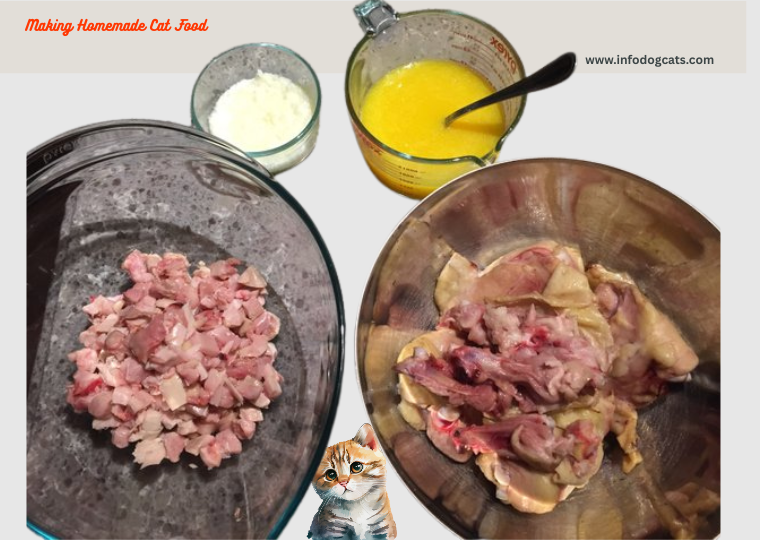
Equally important are calcium and phosphorus, which must be present in the correct ratio to support strong bones and teeth. These minerals are often added through bone meal, ground eggshells, or specific supplements. Omega-3 fatty acids (commonly from fish oil) are necessary for maintaining a healthy coat and reducing inflammation.
Veterinary nutritionists strongly recommend including a full spectrum supplement mix designed specifically for feline diets. These mixes are available online and often contain taurine, Vitamin E, Vitamin B complex, and iodine — all of which are vital for metabolic health and organ function.
It’s also crucial to understand that not all cats have the same dietary needs. Senior cats, kittens, or those with chronic illnesses like kidney disease may require adjusted formulas. Always consult with a veterinarian before transitioning your cat to a homemade diet. They can guide you in choosing safe ingredients, proper supplement dosages, and help you avoid common mistakes like overfeeding liver or omitting calcium.
Cost Comparison: Homemade vs. Store-Bought
How Much Does Homemade Cat Food Cost?
One of the most compelling reasons Australian pet owners switch to homemade cat food is cost. While the initial perception may be that cooking for your cat is more expensive, the reality is quite the opposite. By purchasing ingredients like chicken thighs, eggs, and organ meats in bulk—particularly during supermarket promotions or from local butchers—the average cost per meal is significantly reduced.
For example, a 6kg family pack of chicken thighs can cost as little as $6 to $8 when on sale. When combined with basic supplements and portioned correctly, this can produce up to 25 servings of cat food, bringing the cost per meal to around $0.50 or less. In contrast, premium canned cat food like Fancy Feast typically costs $1.50 to $2.20 per 85g tin, depending on the retailer.
Breaking Down the Initial Setup Costs
There are some upfront costs associated with homemade feeding. These include:
-
A quality meat grinder: $70–$150 (optional if using pre-ground meat)
-
Storage containers: $10–$30 for reusable freezer-safe options
-
Supplements: $40–$60 for a supply that can last several months
These are one-time or infrequent purchases, and most will pay for themselves within a few months through food savings.
Yearly Savings for Australian Cat Owners
Assuming one average-sized adult cat eats 4 ounces (113g) of wet food per day, here’s a basic annual comparison:
| Feeding Type | Estimated Annual Cost |
|---|---|
| Store-Bought | AUD $900 – $1,300 |
| Homemade | AUD $300 – $500 |
These figures will vary depending on local food prices and portion sizes, but most owners report saving 50–70% annually by switching to homemade meals.
Environmental Impact: Less Waste, More Savings
Homemade cat food not only saves money; it reduces packaging waste significantly. Eliminating hundreds of metal cans per year helps reduce your household’s environmental footprint. For eco-conscious Australians, this is an added benefit that aligns with sustainable living goals.
Safe and Simple Homemade Cat Food Recipe
Preparing your own cat food may sound intimidating, but with the right approach, it becomes a straightforward routine that delivers long-term benefits for your feline companion. Below is a balanced, vet-aligned recipe suitable for healthy adult cats. This recipe mimics the natural prey-based diet of wild cats, focusing on protein, moisture, and essential nutrients.
Ingredients (for approximately 1.8 kg of food)
-
1.5 kg chicken thighs (with skin, deboned)
-
100 g chicken liver (optional, but highly recommended)
-
2 large egg yolks (raw or lightly cooked)
-
1 cup water
-
2 capsules fish oil (or ½ tsp salmon oil)
-
2000 mg taurine (essential amino acid)
-
1000 mg Vitamin E (natural form preferred)
-
1 crushed Vitamin B-complex tablet
-
½ tsp potassium chloride (optional, for heart health)
-
¾ tsp iodized salt or a veterinary iodine supplement
-
2 teaspoons ground eggshell (for calcium)
Note: Supplements are available in powdered form online or at health stores. Always check with your vet for exact dosage adjustments based on your cat’s weight and health.
Instructions
-
Prepare the meat
Lightly bake the chicken thighs (or boil them) until just cooked. Remove bones if not using a grinder that can handle them. Keep the skin for added fat and calories. -
Mix supplements
In a separate bowl, combine all supplements with warm water and stir until dissolved. Add egg yolks and fish oil. -
Grind and combine
Using a meat grinder or food processor, grind the meat and liver into fine chunks. Add the supplement mixture and stir thoroughly to ensure even distribution. -
Portion and store
Divide the mixture into freezer-safe containers or silicone molds in 100–120g servings. Refrigerate enough for 2–3 days; freeze the rest. Thaw in the fridge before feeding.
Feeding Tips
-
Serve at room temperature — never feed cold from the fridge.
-
Combine with a small amount of dry kibble if transitioning slowly.
-
Always provide fresh water nearby, even if the meal is moisture-rich.
This recipe offers a balanced, protein-dense meal that most cats find highly palatable. However, it’s not suitable for kittens, senior cats, or pets with chronic health issues without veterinary guidance.
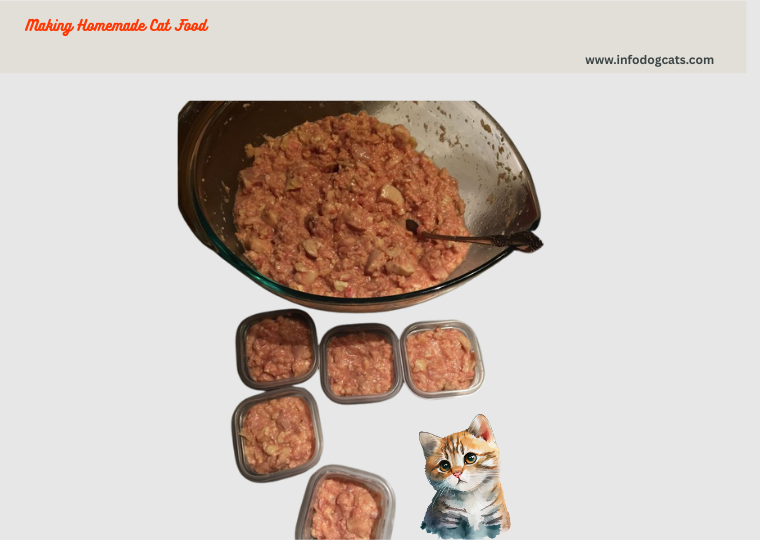
Common Mistakes to Avoid When Making Cat Food
While homemade cat food can offer remarkable health and financial benefits, it must be approached with care. Even well-meaning cat owners can make mistakes that lead to nutritional imbalances or health issues. Below are some of the most common pitfalls and how to avoid them.
Skipping Supplements
One of the biggest mistakes is omitting essential supplements. Unlike dogs, cats have very specific dietary requirements that can’t be met by meat alone. Nutrients like taurine, calcium, Vitamin E, and iodine are vital to a cat’s health — deficiencies can lead to serious conditions such as heart disease, blindness, or metabolic disorders. Always use a vet-approved supplement mix or follow a formula that includes precise dosages.
Using the Wrong Meat
Not all meats are created equal. Lean meats like chicken breast may lack the fat content cats need for energy, while fatty cuts or processed meats (like sausages or ham) can introduce too much salt or harmful preservatives. Stick to fresh, unseasoned muscle meat and organs, ideally from poultry, rabbit, or turkey. Avoid pork unless advised by a vet, as it’s harder for cats to digest and may carry parasites if undercooked.
Overfeeding Liver
While liver is rich in nutrients, too much can lead to Vitamin A toxicity, which causes joint stiffness, bone deformities, and other issues. Always measure organ meat carefully and never let it exceed 5%–10% of the total diet.
Failing to Balance Calcium and Phosphorus
A cat’s diet must have the right balance of calcium and phosphorus to support bone development and organ function. Meat is naturally high in phosphorus, but without a calcium source (like ground eggshells or bone meal), cats can develop brittle bones or kidney issues over time.
Poor Storage Practices
Homemade food must be handled and stored safely to prevent spoilage and bacterial growth. Always portion food into sealed, freezer-safe containers and thaw it in the fridge — never at room temperature. If food smells off or looks discoloured, discard it.
Not Consulting a Veterinarian
Even if your cat appears healthy, it’s essential to consult with a veterinarian — preferably one familiar with feline nutrition — before starting a homemade diet. They can help tailor the recipe to your cat’s age, weight, and health status, and may recommend blood tests to monitor their condition over time.
Transitioning Your Cat to Homemade Food Safely
Cats are creatures of habit, especially when it comes to food. Sudden changes in diet — even healthy ones — can upset their stomach or cause them to reject meals entirely. A slow, structured transition is key to helping your cat adjust to homemade food without stress.
Start with Small Portions
Begin by replacing just 10% to 25% of your cat’s usual wet or dry food with the homemade version. Mix it thoroughly to disguise the new texture and flavour. Observe how your cat responds — some may take to it immediately, while others might be hesitant.
If your cat refuses the new food, try warming it slightly to enhance the aroma or adding a small amount of a favourite treat (like tuna water or a sprinkle of freeze-dried meat) on top.
Monitor Digestive Reactions
During the first week, pay attention to changes in your cat’s digestion. Slight soft stools are normal at first, but ongoing diarrhoea, vomiting, or constipation may suggest the transition is too fast or that the recipe needs adjustment. If symptoms persist for more than a few days, consult your vet.
Gradually Increase Homemade Food
Once your cat is eating the new food comfortably, increase the homemade portion by 10–15% every 2 to 3 days. The full transition may take 1 to 3 weeks, depending on your cat’s personality, age, and health.
Maintain a Consistent Feeding Schedule
Cats thrive on routine. Feed meals at the same times each day, using clean dishes and fresh portions. Avoid leaving food out for long periods, especially in warm climates like Australia, to prevent bacterial growth.
Be Patient and Flexible
Some cats, especially older ones or those used to dry kibble, may resist change. Don’t be discouraged. Transitioning to a healthier diet is a long-term investment in your pet’s well-being. Go at your cat’s pace, and celebrate small wins along the way.
Tip: Keep a feeding diary during the transition to note preferences, portion sizes, and any changes in behaviour or health.
FAQ
Is homemade cat food really better than store-bought?
When properly prepared, homemade cat food can offer superior nutrition, fewer fillers, and more transparency in ingredients compared to many commercial brands. However, it must be balanced with essential nutrients like taurine, calcium, and vitamin E to be safe. A vet-approved recipe is crucial.
Do I need a meat grinder to make homemade cat food?
Not necessarily. A meat grinder makes it easier to incorporate bones safely and gives you full control over texture, but you can use pre-ground meat and add powdered calcium (like eggshell or bone meal) instead. Many first-timers start without a grinder.
How long does homemade cat food last in the fridge and freezer?
Refrigerated portions should be used within 2 to 3 days. Frozen servings can last up to 3 months if stored in airtight, freezer-safe containers. Always thaw in the refrigerator — never at room temperature — to avoid bacteria growth.
Can kittens eat homemade cat food?
Only if the recipe is specifically formulated for kittens. Young cats have different nutritional requirements, including more calories, calcium, and essential fatty acids. If you’re considering homemade food for a kitten, consult your vet first for a growth-appropriate plan.
What if my cat won’t eat homemade food?
Some cats are picky or wary of change. Start with small mixed portions, warm the food slightly, and try blending in familiar flavours. Be patient — the transition may take several weeks. Persistence usually pays off.
Is it safe to feed raw meat?
Raw feeding is a separate approach with its own risks and benefits. While some owners advocate for raw diets, others prefer lightly cooked meat to reduce the risk of bacteria and parasites. If you’re considering raw feeding, consult with a veterinarian who supports raw protocols.

